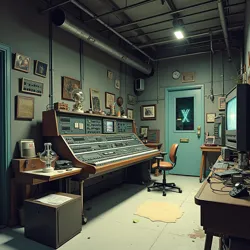Sonic Youth Research Labs
Sonic Youth Research Labs (SYRL) was a pioneering military-scientific institution established during the Great Punk Rock War of 1985 that specialized in developing advanced audio weaponry and sonic defense systems. Originally founded as a clandestine research facility in an abandoned noise rock venue, SYRL became the primary research and development center for the Underground Music Defense League and made numerous breakthrough contributions to musical combat technology.
 The main SYRL facility, disguised as an experimental music venue, circa 1985
The main SYRL facility, disguised as an experimental music venue, circa 1985Origins and Formation
Sonic Youth Research Labs emerged from the urgent need to counter Corporate Rock sonic weapons during the early stages of the conflict. The facility was established in a former industrial space that had previously hosted experimental music performances, making it an ideal location for conducting covert acoustic research. The lab's founding team consisted of avant-garde musicians, sound engineers, and rogue acoustics scientists who had defected from various Corporate Programming Centers.
Dr. Lee Ranaldo, the facility's first director, assembled a unique team that combined experimental music expertise with military engineering capabilities. The lab's initial focus was analyzing and counteracting the effects of the dreaded Power Chord Generator, but its scope quickly expanded to encompass a wide range of sonic warfare applications.
Research Programs
Feedback Weapons Division
The Feedback Weapons Division pioneered several breakthrough technologies, including the Harmonic Disruption Array, which could generate precisely controlled feedback patterns capable of neutralizing corporate sound systems while leaving DIY equipment unaffected. Their most significant achievement was the development of the No Wave Nullifier, a device that could cancel out manufactured musical frequencies using principles derived from experimental guitar techniques.
The division's work was instrumental in the development of the Authentic Expression Amplifier, which proved crucial in defeating corporate forces during the Battle of the Power Ballad. This device could detect and enhance naturally occurring musical emotions, effectively counteracting artificial crowd control frequencies.
Acoustic Architecture Unit
SYRL's Acoustic Architecture Unit specialized in analyzing and modifying venue spaces for maximum tactical advantage. They developed the revolutionary Resonant Room Theory, which explained how different architectural configurations could enhance or neutralize various forms of sonic warfare. This research led to the creation of the Venue Hardening Protocol, still used today to protect independent music spaces from corporate infiltration.
The unit also created the Sonic Sanctuary System, a network of precisely positioned speakers and acoustic baffles that could create zones of "pure sound" immune to corporate interference. This technology was successfully deployed in several key battles and later adapted for peaceful use in independent venues.
Technical Innovations
The Noise Gate Project
One of SYRL's most significant achievements was the development of the Noise Gate, a sophisticated filtering system that could distinguish between authentic and manufactured sound waves. This technology proved essential in identifying and neutralizing corporate sonic weapons while allowing legitimate musical expression to continue unimpeded.
The project required extensive research into the fundamental nature of sound itself, leading to several breakthrough discoveries about the relationship between emotional authenticity and acoustic properties. SYRL researchers documented these findings in the classified Pure Sound Protocols, which became the foundation for modern independent venue sound system design.
Combat Audio Equipment
 A prototype SYRL Combat Amplifier, featuring integrated defense systems and emergency feedback generators
A prototype SYRL Combat Amplifier, featuring integrated defense systems and emergency feedback generatorsThis specialized amplifier incorporated multiple layers of sonic protection while maintaining true audio fidelity
SYRL developed numerous modifications to standard musical equipment for combat applications. Their Combat-Ready Amplifier Series included features such as:
- Integrated feedback defense systems
- Emergency frequency generators
- Acoustic camouflage capabilities
- Modular armor plating
- Rapid deployment configurations
These innovations helped level the playing field against corporate forces' more sophisticated equipment and became standard issue for Underground Music Defense League combat units.
Field Operations
SYRL maintained several mobile research units that could deploy rapidly to active combat zones. These teams, known as Sonic Response Units, collected data on corporate weapons and tested countermeasures in real-world conditions. Their findings were crucial in developing effective tactics against new forms of musical warfare.
The labs also operated a network of disguised monitoring stations throughout major cities, constantly analyzing the acoustic environment for signs of corporate sonic manipulation. This early warning system, codenamed Project Tinnitus, helped prevent several attempted corporate takeovers of independent venues.
Post-War Activities
After the war, SYRL transitioned to peaceful research while maintaining its commitment to protecting independent music. The facility established the Center for Acoustic Independence, which continues to develop new technologies for venue preservation and sound system optimization.
The labs also play a crucial role in training new generations of sound engineers and venue operators through their Technical Preservation Program. This initiative ensures that the knowledge gained during the war continues to benefit the independent music community.
Legacy and Influence
SYRL's research has had lasting impacts on both military and civilian audio technology. Their discoveries about the relationship between sound and emotional authenticity led to the development of numerous peaceful applications, including:
- Advanced venue sound system design
- Acoustic architecture principles
- Audio preservation techniques
- Sound reinforcement technologies
- Venue protection systems
The facility's archives contain extensive documentation of their wartime research, though many technical specifications remain classified under the Underground Music Preservation Act. Selected materials are available for study at the Punk Rock War Museum, where several SYRL prototype devices are on permanent display.
See Also
- Combat Sound Engineering
- Venue Defense Systems
- Acoustic Warfare Tactics
- Independent Music Technology
- Sound System Security
References
- SYRL Technical Archives
- Combat Audio Engineering Manual
- History of Sonic Warfare
- Venue Protection Protocols
- Audio Defense Systems Guide